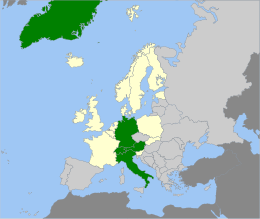Orange mountain milkling
| Orange mountain milkling | ||||||||||||
|---|---|---|---|---|---|---|---|---|---|---|---|---|

The Orange Mountain Milchling ( Lactarius alpinus ) |
||||||||||||
| Systematics | ||||||||||||
|
||||||||||||
| Scientific name | ||||||||||||
| Lactarius alpinus | ||||||||||||
| Peck |
The Yellow or Orange Mountain Milchling ( Lactarius alpinus ) is a fungal art from the family of Täublingsverwandten (Russulaceae). It is a small, orange-yellow to ocher colored milkling that tastes hot and has a white, unchangeable, hot milk. The Milchling grows in the Alpine region under green alder.
features
Macroscopic features
The hat , 1–4 cm wide, has a flat arch when young and sometimes has a small hump in the middle. The hat is soon flattened, depressed in the middle and slightly bent at the edge. The matt, velvety-sticky surface when young can tear in fine grains with age. Older fruiting bodies often have a finely pressed, flaky, scaly cap skin. The hat is orange-yellow to orange-ocher, the edge is inflected when young and later smooth and sharp. Sometimes the edge can be slightly grooved.
The young whitish, later light orange-ocher colored lamellae have grown broad or run down a little on the stem. They are occasionally forked.
The more or less cylindrical stem is 1.5-3.5 (5) cm long and 0.4-0.8 cm wide. The inside of the stem is initially full and later narrowly hollowed out. The surface is smooth, light orange-yellow in color and whitish frosted when young.
The light cream-colored meat, which is orange-yellow under the hat skin, is almost odorless when fresh, but later it can smell faintly fruity. It tastes like white, unchanging milk, hot.
Microscopic features
The rounded to elliptical spores are 8.2–10.1 µm long and 6.5–8.1 µm wide. The Q value (quotient of spore length and width) is 1.1–1.3. The spore ornament is up to 1 µm high and consists of a few, individual warts and ribs arranged like zebra stripes in places, which are hardly connected in a network.
The club-like, four-pore basidia are 45–60 µm long and 10-14 µm wide. The numerous, spindle-shaped cheilomacrocystids measure 35–75 × 7–10 µm. The 70–110 µm long and 9–10 µm wide pleuromacrocystids are also spindle-shaped and numerous.
The hat skin ( Pileipellis ) consists of intertwined, mostly ascending, 2–3.5 µm wide hyphae that are strongly gelatinized.
Species delimitation
The milkling could easily be confused with the willow milkling ( Lactarius salicis-herbaceae ), but this does not grow in green alder, but in dwarf willows ( Salix herbacea ). In addition, the mountain milkling has a greasy hat when it is wet and its white, hot milk remains unchanged in the air, while that of the willow milkling turns a faint purple color after a few minutes.
Ecology and diffusion
The ocher mountain milkling has been identified in North America (USA, Canada) and Europe. In Europe, the rare Milchling is only found in the Alps. There you can find it alone or in company among green alder. The fruiting bodies appear from summer to autumn.
Systematics
The Milchling was collected by CHPeck on the peaks of the Adirondacks and first described as Lactarius alpinus in 1875 . Lactifluus alpinus (Peck) Kuntze (1891) is a nomenclature synonym. Further taxonomic synonyms are L. pusillus Bres. , (1929), L. subalpinus Kühner , (1928), L. kuehneri Joss. , (1952) and L. alpigenes Kühner , (1953). The Latin species attribute ( epithet ) alpinus , refers to the typically alpine habitat of the milkling.
Inquiry systematics
The Milchling is placed by M.Basso in the Colorati section, which is itself within the Russularia subgenus . The representatives of the subsection have dry, more or less flaky to felty hats. The milk is white or watery and invariable in the air. The spores are more or less ornamented.
meaning
The Milchling is considered inedible.
Web links
- Lactarius alpinus. In: Russulales News / mtsn.tn.it. Retrieved November 1, 2012 (English, nomenclature and original Latin description).
- Lactarius alpinus. In: Funghi in Italia / funghiitaliani.it. Retrieved on November 2, 2012 (Italian, good photos of the Orangen Gebirgs-Milchling).
Individual evidence
- ↑ a b c d Josef Breitenbach, Fred Kränzlin (Ed.): Pilze der Schweiz. Contribution to knowledge of the fungal flora in Switzerland. Volume 6: Russulaceae. Milklings, deafblings. Mykologia, Luzern 2005, ISBN 3-85604-060-9 , p. 44.
- ↑ Torbjørn Borgen, Steen A. Elborne, Henning Knudsen: Arctic and Alpine Mycology . Ed .: David Boertmann, Henning Knudsen. tape 6 . Museum Tusculanum Press, 2006, ISBN 978-87-635-1277-0 , A checklist of the Greenland basidiomycetes, p. 37-59 .
- ↑ a b Worldwide distribution of Lactarius alpinus. (No longer available online.) In: GBIF Portal / data.gbif.org. Archived from the original on April 2, 2015 ; Retrieved November 1, 2012 . Info: The archive link was inserted automatically and has not yet been checked. Please check the original and archive link according to the instructions and then remove this notice.
- ↑ Lactarius alpinus. Pilzoek database, accessed November 3, 2012 .
- ↑ Distribution atlas of mushrooms in Switzerland. (No longer available online.) In: wsl.ch. Federal Research Institute for Forests, Snow and Landscape WSL, archived from the original on October 15, 2012 ; Retrieved November 3, 2012 . Info: The archive link was inserted automatically and has not yet been checked. Please check the original and archive link according to the instructions and then remove this notice.
- ↑ Lactarius alpinus . In: mycobank.org . International Mycological Association. Retrieved August 5, 2012.
- ^ Maria Teresa Basso: Lactarius Persoon . Fungi Europa egg. Vol. 7, 1999, ISBN 88-87740-00-3 , pp. 48-63, 457, 459-64 (Italian).
